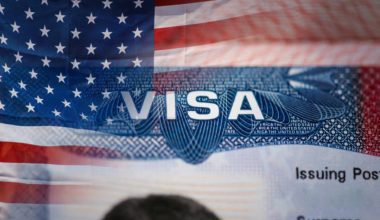Are you a skilled construction worker looking to relocate to the United States? Due to a significant labor shortage in the construction industry, employers are offering attractive incentives to foreign workers. With the U.S. Construction Visa Program, eligible workers can receive up to $80,000 in financial support to cover relocation expenses and housing costs.
This program not only offers stable employment, but also provides a pathway to work and live legally in the USA. This article explains everything you need to know about the U.S. Construction Visa Program, including eligibility requirements, visa options, and benefits.
Why the U.S. Needs Foreign Construction Workers
Because of rapid infrastructure development and a shrinking domestic labor force, demand for construction workers in the United States has skyrocketed.
In order to fill these gaps, the U.S. government and private construction companies are now recruiting foreign labor. Construction Visa Sponsorship Program has opened doors for skilled international workers.
A report by the U.S. Bureau of Labor Statistics predicts that the construction industry will grow by 4% annually through 2032, creating hundreds of thousands of jobs.
Carpenters, electricians, plumbers, welders, and general laborers are among these positions. Foreign recruitment has become necessary due to the inability of local workers to meet this demand.
Furthermore, the U.S. government has increased investments in roads, bridges, schools, hospitals, and renewable energy facilities.
In order to complete these projects, a large number of people will be needed, and domestic labor alone cannot satisfy the demand. For this reason, employers are offering visa sponsorship as well as financial incentives in order to attract skilled foreign workers.
Benefits of the U.S. Construction Visa Program
For skilled workers looking for a better future, the Construction Work Visa USA Program offers many advantages. There are a number of benefits, including:
1. Financial Incentives Up to $80,000
Up to $80,000 in assistance can be received by qualified workers, covering the following costs:
-
Relocation expenses
-
Housing costs
-
Daily living expenses during the initial months
Providing financial support to workers ensures a smooth transition to life in the United States.
2. High-Paying Jobs
Depending on skill level, experience, and location, construction workers in the U.S. earn an average annual income of $50,000 to $80,000. Some highly specialized trades, including electricians, welders, and plumbers, can earn more than $100,000.
There are also differences in wages by state, with California, New York, Texas, and Florida reporting higher earnings. There are many options available in terms of location, salary potential, and cost of living.
3. Visa Sponsorship
You can legally work and live in the United States if you are employed by an employer who facilitates the entire visa process. An employee sponsorship program simplifies immigration paperwork and provides a clear pathway to employment.
4. Career Growth Opportunities
There are many benefits to working in the U.S. construction industry, including:
-
Advanced training programs
-
Professional certifications
-
Promotions and leadership roles
Employees can enhance their skills on-the-job while earning a salary by receiving on-the-job training. Additionally, construction certifications issued by U.S. companies are recognized internationally, thereby increasing job opportunities abroad.
5. Health and Employment Benefits
There are many U.S. construction employers that offer comprehensive benefits, such as:
-
Health insurance
-
Dental and vision coverage
-
Pension plans
-
Paid vacation and sick leave
-
Workers’ compensation for job-related injuries
These benefits ensure that workers and their families have access to quality healthcare and financial security.
6. Pathway to Permanent Residency
The EB-3 Skilled Worker Visa, for example, provides an avenue to permanent residency (Green Card) for those seeking long-term opportunities. By obtaining this visa, workers can live and work in the United States indefinitely and apply for citizenship if they wish.
Who is Eligible for the U.S. Construction Visa Program?
The following requirements must be met in order to qualify for a U.S. work visa for construction jobs:
-
Experience in Construction Trades: There is a high demand for skilled trades such as carpentry, electrical work, plumbing, masonry, welding, roofing, and general labor.
-
Vocational Training or Certifications: Although not always mandatory, trade school training, apprenticeships, and professional certifications can boost your chances of getting hired.
-
Basic English Proficiency: Many employers require a certain level of English proficiency to maintain safety and communication.
-
Clean Background and Health Record: Applicants must undergo a medical examination and a background check.
-
Employer Sponsorship: To process a visa, a valid job offer is required from a U.S. employer.
-
Age Requirement: Applicants must be 18 or older to apply for most programs.
-
Willingness to Relocate: In order to work in the United States, workers must be able to adapt to new working conditions and move to the country.
Visa Options for Foreign Construction Workers
There are different visa categories available to foreign workers seeking construction jobs in the U.S. Among the most common are:
1. H-2B Temporary Work Visa
H-2B Visas are designed for seasonal and temporary non-agricultural workers, including those in construction.
-
Duration: Initially granted for up to one year, extendable up to three years.
-
Requirements: Employer sponsorship required.
-
Best for: Short-term employment with renewal possibilities.
H-2B visas are ideal for construction workers seeking temporary work, such as those working on projects with a specific timeline. Upon completion of the project, workers may return home or seek employment with another employer.
2. EB-3 Skilled Worker Visa (Green Card Pathway)
Work visas for skilled and unskilled construction workers are available under the EB-3 program.
-
Duration: Leads to permanent residency (Green Card).
-
Requirements: Employer sponsorship and labor certification required.
-
Best for: Long-term career opportunities and those seeking permanent residency.
It is the perfect visa category for workers who plan to establish long-term careers in the United States. In addition, dependent visa categories allow families to join the worker.
3. TN Visa (For Canadians and Mexicans)
Under the USMCA trade agreement, Canadian and Mexican workers are eligible for TN Visas.
-
Duration: Up to three years, with renewal options.
-
Requirements: A job offer in a qualifying occupation.
-
Best for: Canadian and Mexican professionals in construction trades.
How to Apply for a U.S. Construction Visa
Obtaining a U.S. Construction Work Visa requires several steps. The following step-by-step guide will help you through the process:
Step 1: Find a Sponsoring Employer
Research U.S. construction companies that hire foreign workers. There are many companies that advertise their job openings on job boards and recruitment agencies. Seek out visa sponsorship companies with experience.
Step 2: Submit Your Application
Make your resume stand out by highlighting the following:
-
Construction skills and expertise
-
Work experience
-
Certifications and training
You should tailor your application to each job, emphasizing relevant skills.
Step 3: Secure a Job Offer
Upon hiring you, your employer will provide you with a job offer letter, which is essential for obtaining a visa. It is important to ensure that you have a clear understanding of your role, pay, and conditions of employment in the job offer.
Step 4: Apply for a Work Visa
If you are applying for a H-2B visa or EB-3 Green Card, your U.S. employer will assist you with the required paperwork. In order to do this, you need to complete Form I-129 (Petition for a Nonimmigrant Worker) and submit it to the United States Citizenship and Immigration Services (USCIS).
Step 5: Attend Your U.S. Visa Interview
You can schedule an interview at the nearest U.S. embassy or consulate in your country. Provide details about your job, your background, and your plans for relocation.
Step 6: Receive Your Visa and Relocate
Upon approval of your visa, you can move to the United States and start your new job immediately. As soon as you arrive, ensure you comply with all visa conditions and communicate with your employer.
Tips for a Smooth Relocation Process
The transition to life in a new country can be challenging, but with careful preparation, the process will go more smoothly. Tips to keep in mind:
-
Research Your Employer: Make sure the company is legitimate and actively sponsors foreign workers.
-
Save Extra Money: Although the program offers financial incentives, personal savings are essential in case of emergencies.
-
Improve Your English Skills: Communicating and adjusting to a new environment will be easier if you have basic proficiency in English.
-
Understand Your Rights: Become familiar with U.S. labor laws to protect yourself.
-
Connect with Other Workers: Find support through online forums, community groups, or unions.
-
Plan Your Accommodation: Make housing arrangements in advance to avoid last-minute stress.
-
Know Emergency Contacts: Make sure you have your employer’s contact information and the embassy’s contact information on hand at all times.
Final Thoughts
With visa sponsorship, skilled laborers can seek high-paying construction jobs in the United States with the U.S. Construction Visa Program. There is no better time to take action than now, with a possibility of earning up to $80,000 in relocation incentives.
Interested in starting your journey? Now is the time to apply for the U.S. Construction Visa and begin your career abroad.
Take advantage of this opportunity to build your future in the United States.





